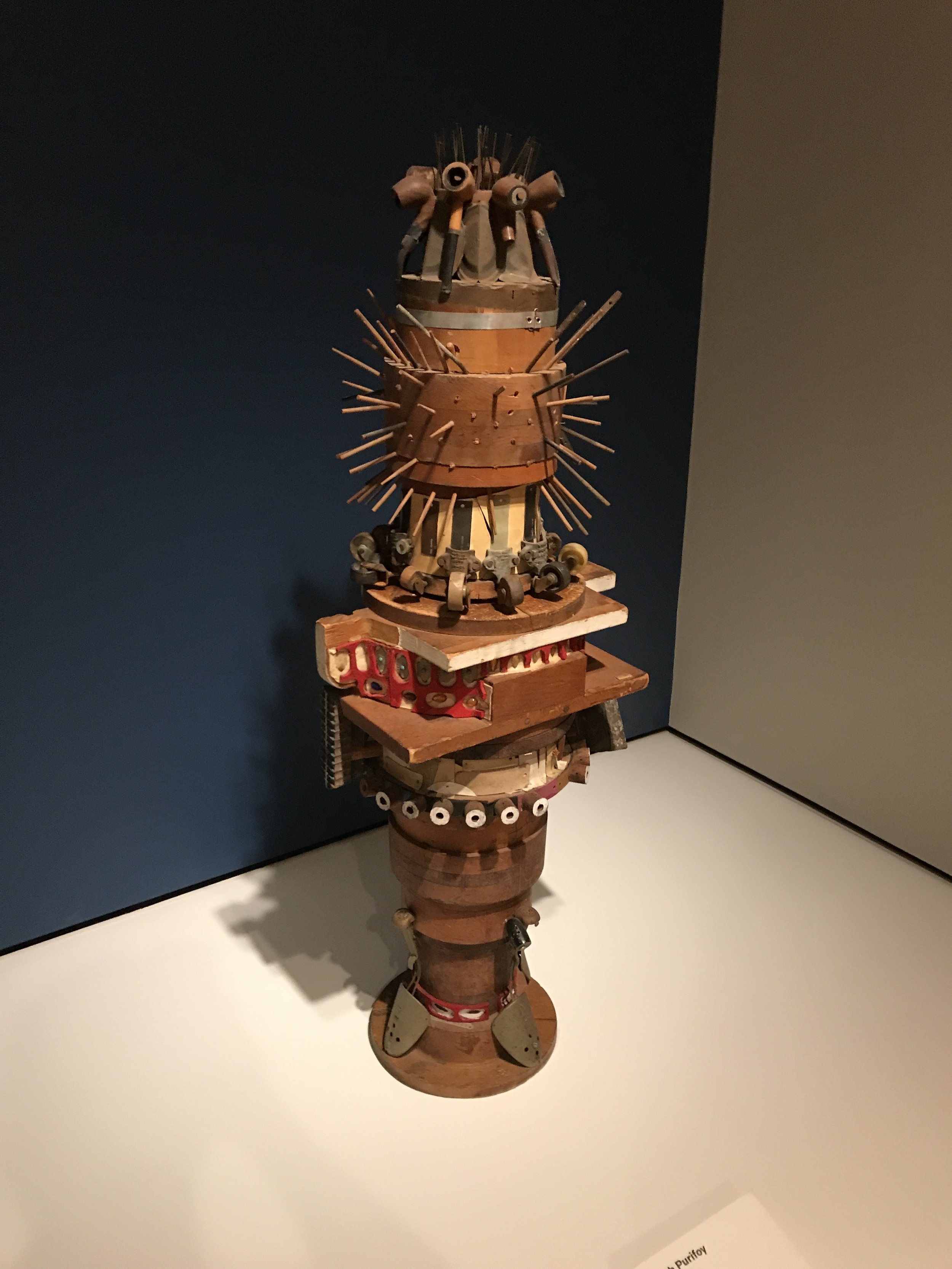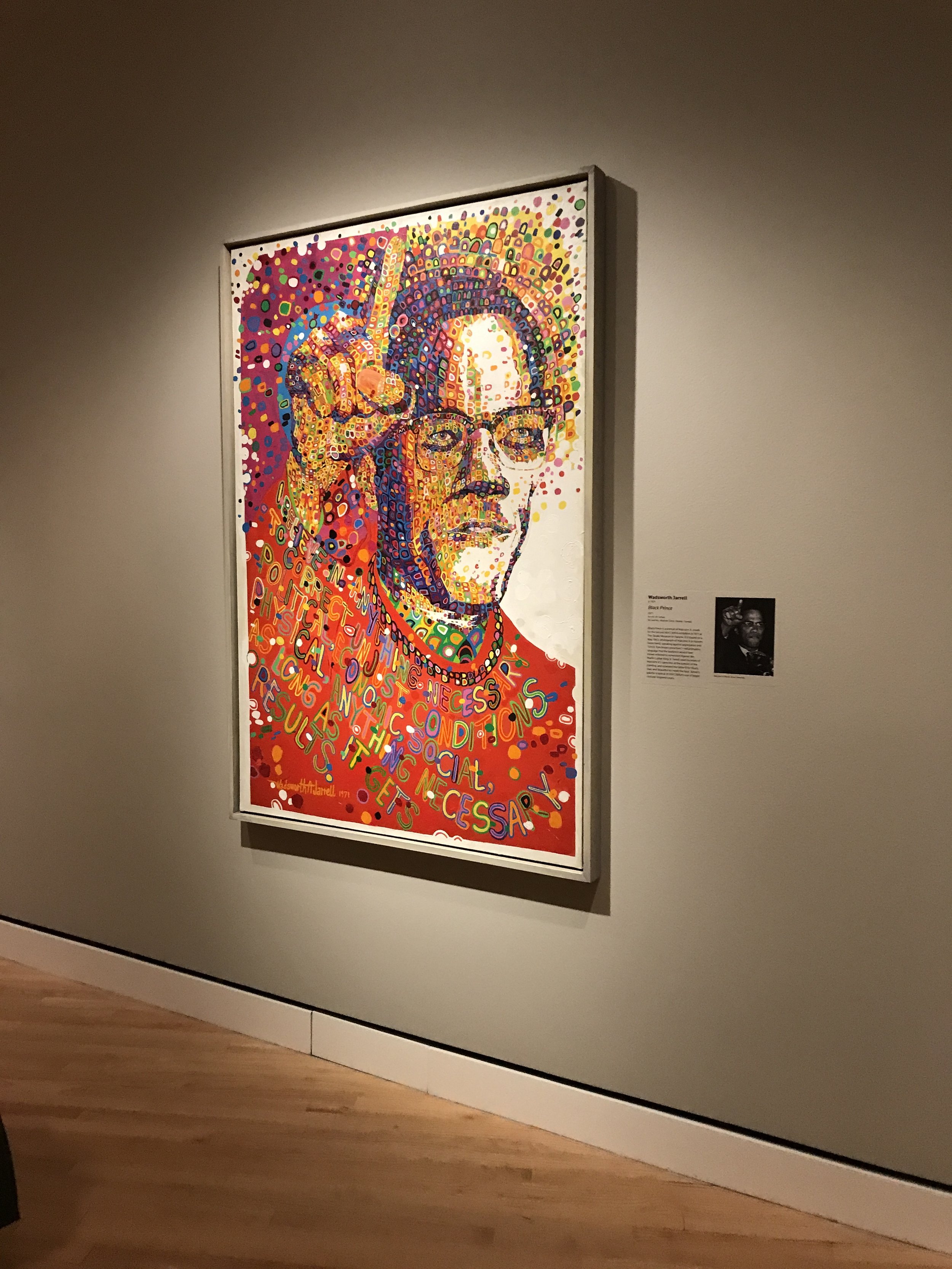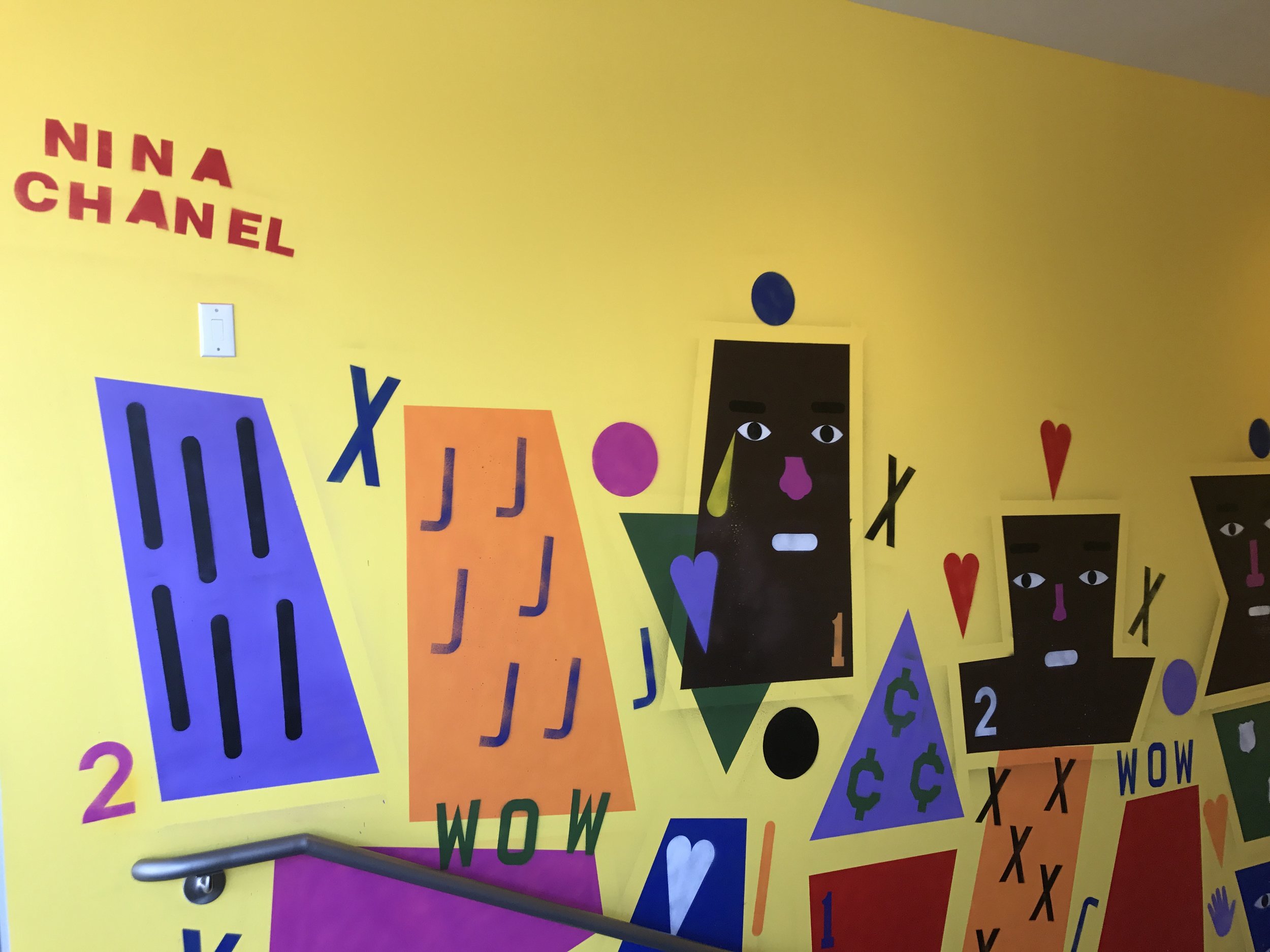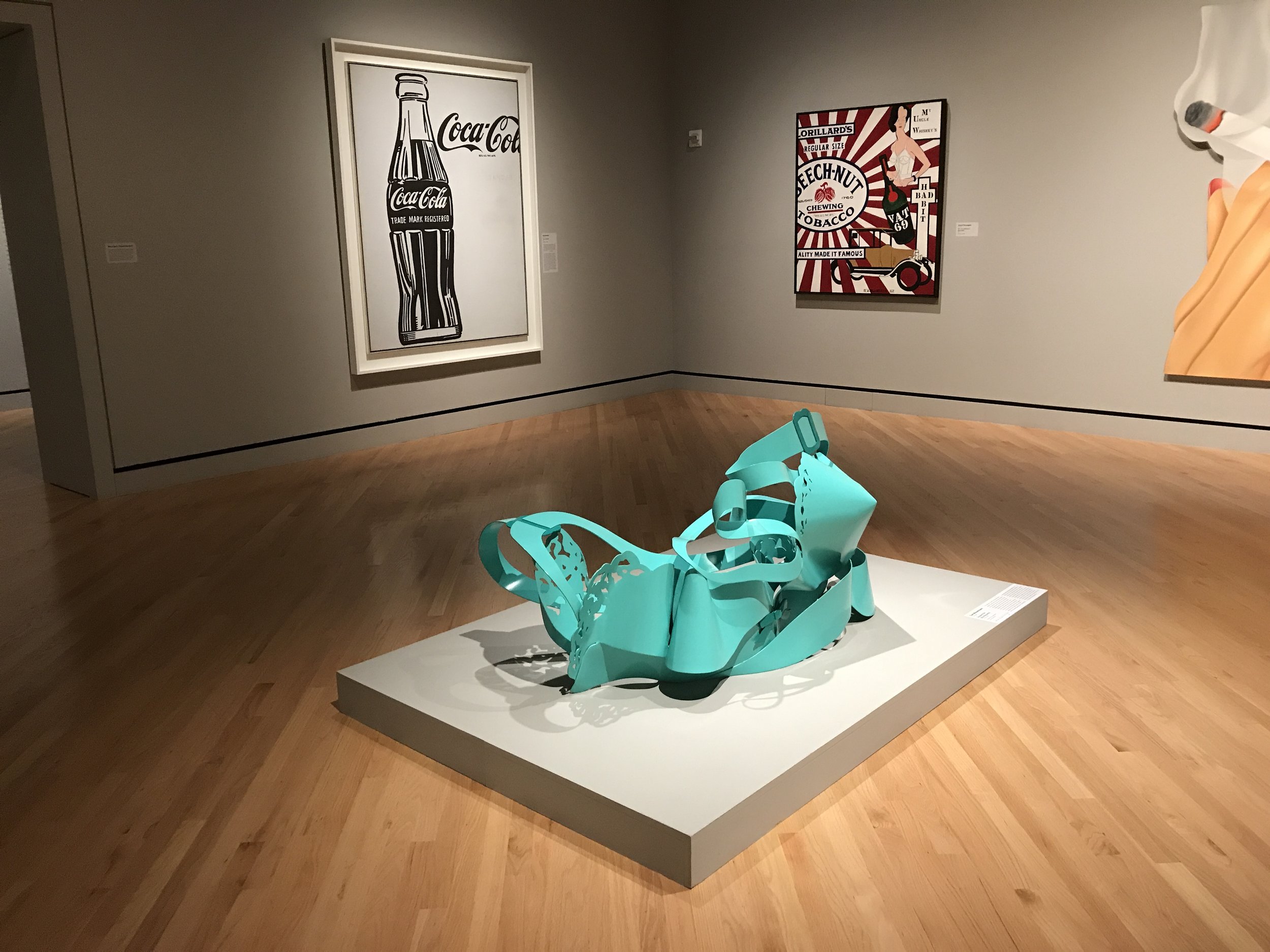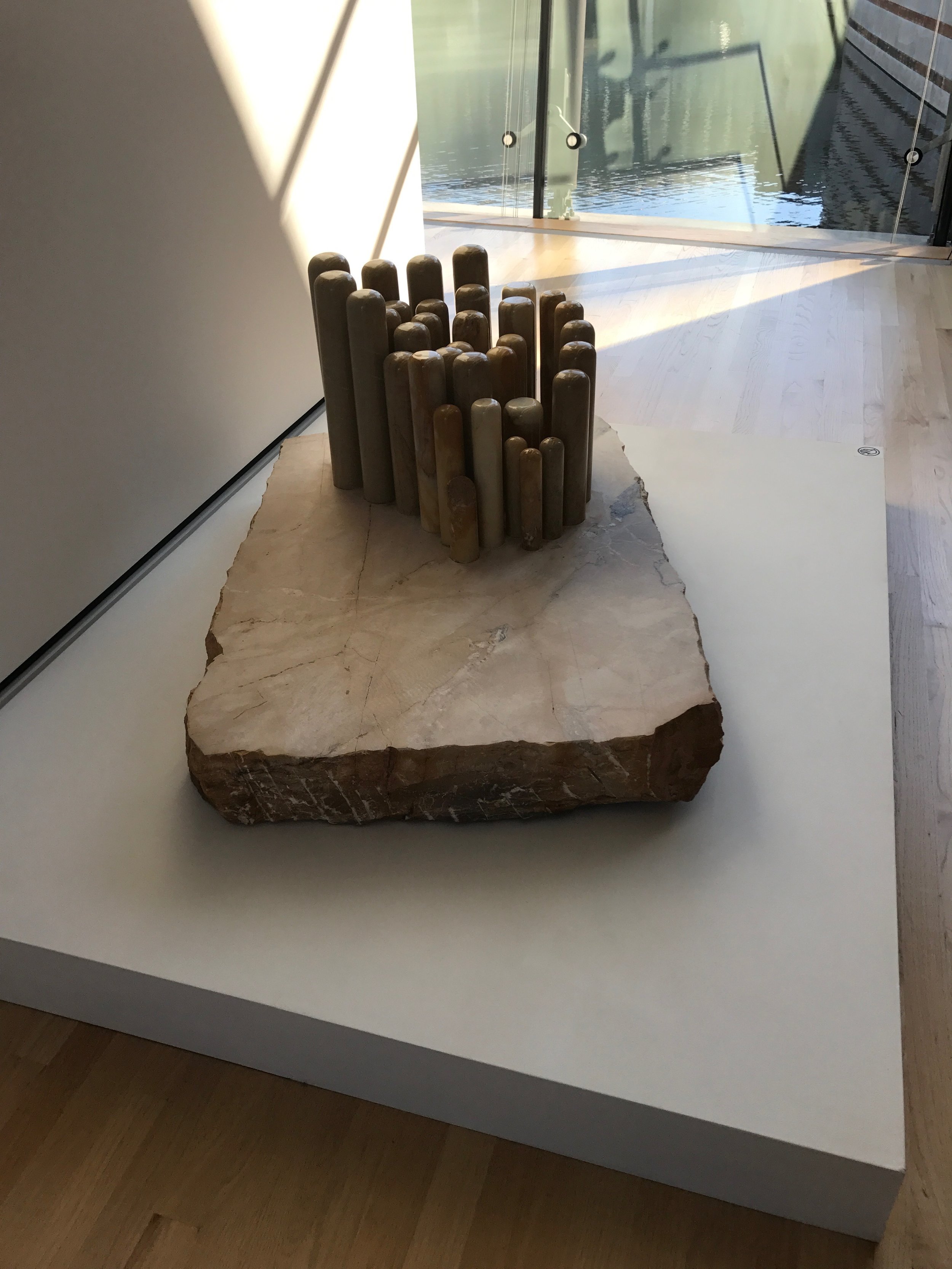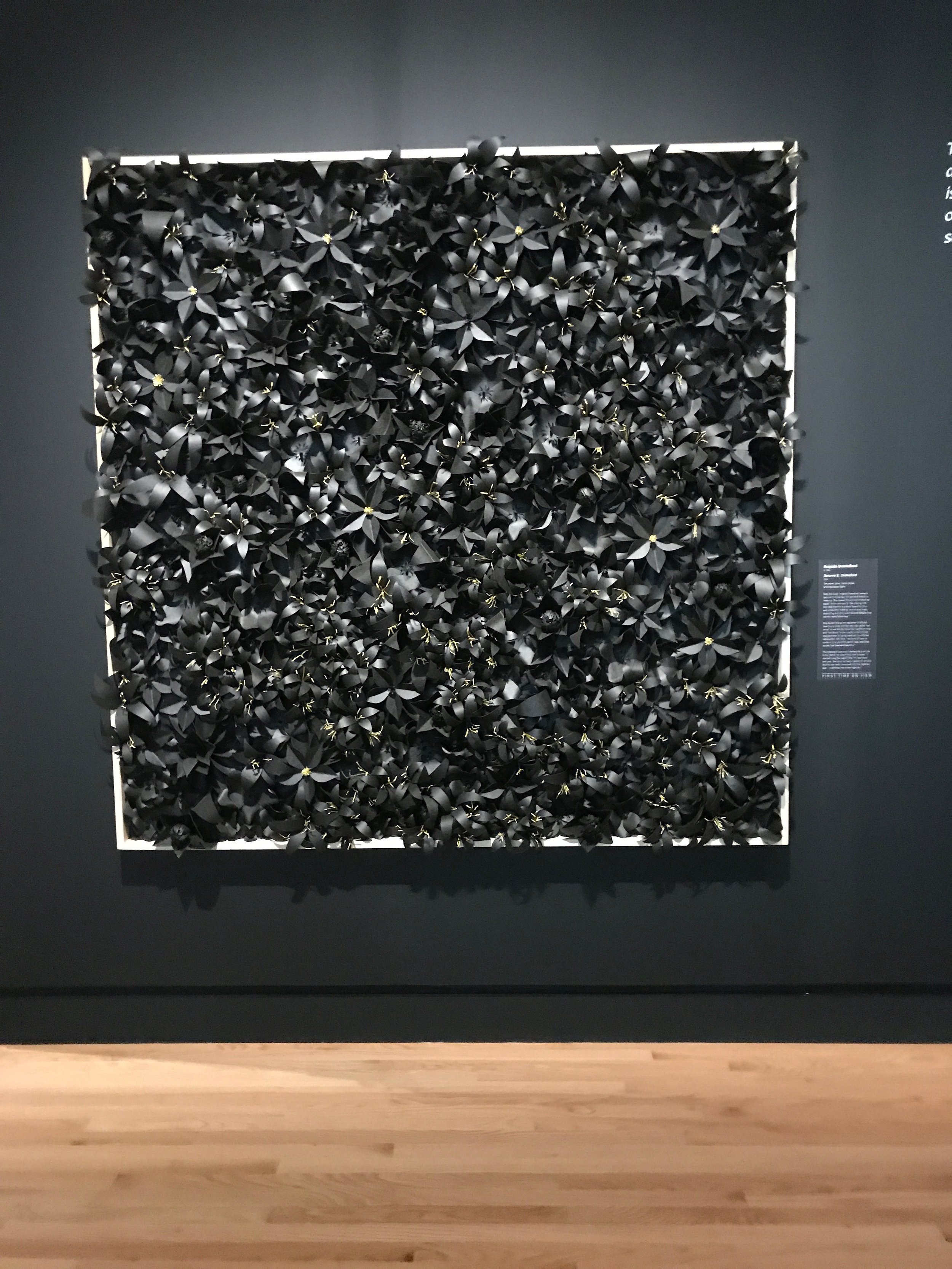AR Day 3- Trolls, Trails, and Terrific Museums
Today was a really great day of exciting displays of human creativity. The day started with some coffee at a place called Arsaga's in Fayetteville. I got sold on a fancier coffee than I usually get called a Grasshopper, which had cold brew coffee, chocolate milk, and house made mint syrup. It was really delicious, and in a happy coincidence one of the comics from the night before was working there so we got to talk about what a fun time that was. The other cool thing about the coffee shop was that it was in a little shopping center called the Depot. As the name suggests, the Depot is an old train depot, and the coolest thing for me to see was that the Bank of Fayetteville actually has a branch in one of the old train cars. That way if they ever start going under they can fire up the old engines and make a run for it, presumably.
My next stop was real treat on the outer reaches of Fayetteville, an artist collective called Terra Studios. It was an incredible and whimsical blend of imaginative art, naturally beautiful Northwest Arkansas scenery, and a whole lot of trolls. From the moment you enter the studio's campus, you're greeted with an incredible array of sculptures, ceramics, and glass artwork, but the ones that stand out the most are definitely all the helpful trolls hanging out around the place, ready to gobble up your trash.
I think trolls are normally portrayed as disgusting, but these ones were really cute, and even had their own parking spaces. I also really liked that one of the tiles outside their bathroom went a similar route of making terrifying things adorable by proclaiming "chaos is fun!' I knew right out the gate I was going to really like this place.
The studio was founded by a married couple of artists who were a master glassblower and ceramics worker respectively. The studio started as just the two of them, but they soon started teaching classes and taking in other local artists. They eventually added in a cafe and a shop to sell their wares, but they certainly did it with their own style. Every table in the cafe has it's own theme and artistic approach. One was a troll dinner table with trolls above the booth sitting at their own table, one was all fairytale themed with different idyllic fantasy scenes made from different tiles and fairy silhouettes on the lamp, and one featuring different Egyptian and Eastern inspired wooden art and a dessert scene cut into the table with a little plexiglass pane over it so it could still be used as a regular surface. Even the wooden doors of the bathroom took full advantage of the opportunity to be used for fantastical carvings.
The shop portion was filled with works several impressive local artists. What people are able to do with glass and ceramics never ceases to amaze me. There where pigs in hot tubs, rhino vases, singing hillbilly mushrooms (an ozark favorite!), celtic coasters, gourd houses, jack o'lanterns, and even a little fountain.
At the back of the shop was the glass blowing studio where you could watch the artists at work crafting their most popular creation these little Bluebirds of Happiness. They were really cute, and around the center collection of the A-Plus bluebirds were all the discounted not-quite perfect blue birds. I got such a kick out of looking at all the different ways these little things could wrong, from being too pudgy, too long, to just plain dopey looking. I had to pick one of these little misfit toys up, because they just totally stole my heart.
Outside the main building with the cafe and shop was a beautifully serene lake guarded by more trash trolls and featuring cure little cottages for the artists in residence.
In the woods behind the lake, there were trails filled with incredible sculptures and a labyrinth for quiet reflection. I love how well they used the space, making some sculptures very obvious while some really blended in with the trees and greenery. I particularly was impressed by a series of panels featuring different ceramic tiles and woodblocks, because the way they achieved such depth in only two dimensions really made them feel like windows into other worlds.
My very favorite things in the woods though were a little troll family of George, Myrtle, and shy Hubert, and a giant dragon-insect made out of an old water tank. For some reason, it had the message "On my honor I will try. I will do my best" It was the most oddly inspiring giant monster I've ever seen.
The last thing I noticed before I left was a whole gazebo filled with the bluebirds and the way it caught the light was just stunning. What a magical place.
After Terra, my next stop was probably one of the most recommended spots I was told to check out in Arkansas: The Crystal Bridges Museum of American Art. Funded by the Wal-Mart family, Crystal Bridges was designed by architect Moshe Sadfie. The museum consists of a series of wood and glass pavilions floated over two ponds. I'm not the biggest fan of Wal-Mart but all that money did not go to waste because this was easily one of the most beautiful museums I've ever been to. I couldn't even capture the full scope of how amazing looking the museum was in any of my photos so I found a sweet aerial shot from the internet.
One of the odder aesthetic choices was a giant sculpture of a spider in the courtyard before the main entrance by an artist named Louise Bourgeois. The thing that really blew me away though was not the sculpture but the artist's statement in which she wrote, "The spider is an ode to my mother. She was my best friend. Like spiders, my mother was very clever." The sentiment is sweet but I'm not sure I'd be too flattered by the visual.
The other nice thing about that Walmart money is it means the museum is totally free to public! They did however have a charge for the special exhibit, but it was a really cool one so I figured that it would be worth the price of admission. The exhibit was called Soul of a Nation and traced the history of Black American Art movements during the 60's and 70's. It was really a perfect collection of art that could stand on its own aesthetic merit but which also had grander historical and social merit because of the themes and moments that were being addressed. The art was curated roughly chronologically by different arts movements or key exhibitions, and it was very interesting to see how these different artists tried to express similar themes in such wildly different ways while also reacting to one another. It's easy to think that art can exist in a vacuum once it's carefully placed on a museum wall, but it's so cool to see how dynamic and alive and in conversation with one another all these artists were at the time.
The first movement in the exhibit was a collective of Black artists founded in 1963 called Spiral. As one of the first major groups comprised entirely of African-American Artists, they really tried to interrogate what it meant to be a Black artist in America and if there was such a thing as uniquely black art, questions that the fine arts world had largely ignored. The group consisted of some pretty prominent artists such as Hale Woodruff, Reginal Gammon, Romare Bearden, and Norman Lewis, and the pieces selected from this exhibit came from a 1965 show where every member of the group presented works that just used Black and White. I was particularly impressed by Romare Bearden's hauntingly inventive collage works and Norman Lewis's seemingly abstact paintings that upon closer inspection are actually crowds of Klansmen disrupting the black backgrounds.
The next movement on display was African American art from and on the street. These included photos and early drafts from the influential mural The Wall of Respect in Chicago celebrating different Black cultural heroes. Other pieces from this section included "Free Huey" lithographs that were passed out on the street after Huey Newton was arrested, different photos of street art, and a really impressive but very depressing poster by an artist named Faith Ringgold called the United States of Attica that featured a detailed account of police brutalities and murders and where in the US they occurred. The posters were handed out and people were encouraged to make additions of new events and hold people accountable. The sheer amount of the poster covered in writing was really alarming.
The next movement on display was the Black Arts Movement which featured a loose collective of different artists trying to make art directly for Black people in the US, incorporating major symbols like the Black Power fist, American flags, and portraits of prominent Black leaders.
My favorite pieces from this movement were a darkly gothic painting by Archibald Motley Jr. that featured images of American's darker racial legacy mixed in with more biblical images of evil superimposed over a haunted house looking Southern Mansion, and a more positive and uplifting sculpture called Black Unity by Elizabeth Catlett that on one side was a raised Black Power Fist. On the reverse side of the fist were two serene smiling Black faces. While the painting highlights the dark past, the sculpture imagines a much brighter future.
The next section of the exhibit featured different Los Angeles artists reacting to the Watts Rebellion through Assemblage sculptures that viscerally responded to the violence around them while also tapping into the Abstract expressionist movement dominant in the broader art world. The sculptures used a combination of found objects ranging from shackles to aunt Jemima figurines to funeral clothes in order to reclaim objects associated with suffering and turn them into something beautiful.
The next collective on display was a group called Africobra. Africobra started in Chicago and had an emphasis on color and shine that tried to imbue their art with a sense of African rhythm and style. These pieces were all so vibrant, and I loved the way abstract color patterns would through repetitions become portraits of prominent Black leaders and artists. I also really liked the inclusion of dresses that were inspired by the paintings, because they showed the ways in which the fashion and art worlds intersected and played off one another.
The next series of pieces came from a 1971 LACMA Exhibition called Three Graphic Artists which featured pioneering works by David Hammons, Timothy Washington, and Charles White, marking an important entry point of Black artists into the mainstream. This collection was one of my personal favorites of the whole exhibit because these three dudes were just so inventive and talented. David Hammons created pieces by having models cover themselves in paint and actually make an imprint on the canvas by lying on it. This combination of flatness and realness gave his paintings a really surreal sense of authenticity.
I almost didn't even notice how cool Timothy Washington's pieces were because at a quick glance they look like just regular paintings, when in fact they are really carefully engraved metals. That blew me away when I read that, because I did not even know it was possible to get so painterly with aluminum and recycled car parts.
And last but certainly not least of the three artists from this Exhibition was Charles White, who was able through just classic oil and cancas create not just photorealistic portraits, but also cleverly create the illusion that these portraits were printed on different materials such as maps, wanted posters, and postcards.
The next collection was one of the smaller ones, but nonetheless impressive, focusing entirely on the photographs of an artist named Roy DeCarava, one of the first prominent African-American fine-arts photographers. His photos imbue black and white urban scenes with a sense of lyricism and wonder. In particular, the one on the right of a naked pregnant woman on a roof in the rain really stuck with me as being an image both almost familiar but totally fantastic.
After the photographs was a collection of pieces by East Coast artists working in the popular form of Abstraction. I liked these works about as much as I like any Abstract pieces with some catching me and others not for reasons I don't fully understand. The thing I found most interesting about these pieces though was their place in the larger cultural conversation going on in the 60s and 70s about the role of Black artists. These East Coast artists actually got a lot of flak from other Black members of the arts community, because these abstract pieces didn't directly relate in any obvious way to the Black experience and in some ways marked these artists as just conforming to what was dominant in the largely white art world. The counterpoint these artists felt was that for Black artists to not partake in any mainstream arts movements would insure that the mainstream remained predominantly white, and that these works spoke to the Black experience simply by virtue of being made by Black artists and there didn't have to be more than that. I just found the whole conversation really fascinating because it's cool to think that images that just seem like random lines, shapes, and colors can spark such intense dialogues about race and identity.
The next series went in a totally different stylistic direction, by focusing on different artists' approach to portraiture in ways that celebrated black bodies as opposed to fetishizing them. I loved the ways different artists let their own modernist touches shine through in their portraits. I also liked that the portrait subjects ranged from heroes like to James Baldwin to everyday people like one of the artist's babysitter. It was really empowering.
I was also really excited to see more paintings by Barkley L. Hendricks, who I was really impressed with from his exhibit in the New Orleans Museum of Art. I particularly liked too paintings that took humorous approaches to issues of mainstream Black (mis)representation. One was a nude self-portrait entitled Brilliantly Endowed which was a play on how one art critic had described one of his shows. He felt that this reduced his talent to the realms of Black Stereotypes, so he leaned in with this defiant portrait of his body nude except for a hat, sneakers, and some cool shades. The other painting that really struck me featured a black man wearing a Superman t-shirt entitled Icon for My Man Superman (Superman Never Saved Any Black People- Bobby Seale). The title references a quote from Black Panther co-founder Bobby Seale, and it really is incredible to think that up until Black Panther, superhero comics could take place in such large cities as Chicago and New York (or their DC alter-egos) and somehow have almost no Black people in them.
The next section came back to Abstraction featuring works from two important 70s exhibitions: The De Luxe Show and 5 +1. The shows featured some figurative artwork mixed in with the abstract, but the pieces that made their way to this current exhibit tended to be abstract with a focus on experimental sculptures. It's interesting that by this point in the 70s there was much less debate as to whether or not Black artists should be engaging with Abstraction, and it was now much more widely accepted as a relevant and meaningful form of expressing the Black experience.
The last section of this exhibit ended things on a really sweet note showcasing the interplay of artists and communities with Photographs from Lorraine O'Grady's performance Piece Art is... In the piece, O'Grady and fifteen actors and dancers marched in community street parade in Harlem holding wooden frames and turning everything they passed into art. It was just pure joy.
After leaving the special exhibit, I went to the main galleries of the museum. To get there though you have to walk down a staircase of art by Nina Chanel that was very endearingly childlike and cartoony
The museum proper started with a pretty extensive collection of Contemporary art. Paintings ranged from abstract to surreal to photorealist, and they had their share of big names. The collection was also housed in a big open gallery in one of the main pagodas so it would have just been a really pleasant space to be in even without all the great art.
Highlights for me included (generally) figurative paintings by Jackson Pollock and Mark Rothko; a pop art room filled with works from Andy Warhol, Roy Lichtenstein, and Tom Wesselman; an uncannily realistic oil painting from an expedition to Antarctica by the artist Richard Estes; an incredible quilt-work tribute to Maya Angelou by Faith Ringgold; a surrealist monochromatic Landacape by Mark Tansey where crumbling faces of world leaders ancient and recent emerge from the rocks; and incredible painting by Kerry James Marshall that featured a Norman Rockwell-esque idyllic 50s scene of children playing with graffiti scrawled on it to make the point that that particular white fantasy was never really a Black reality.
Though the contemporary wing was mostly paintings, there were a few impressive sculptures sprinkled throughout the gallery. My favorites were a piece called Eat Meat by yinda Benglis that looked super blobby and amorphous but was actually cast Aluminum and a piece called Bluffs by Tara Donovan that featured thousands of carefully glued together to form a giant imitation of a rock formation.
Also in the contemporary wing was a hard to classify piece by Felix Gonzalez-Torres called Untitled (L.A.). The piece features hundreds of individually wrapped candies spilled across the floor of a small room. Viewers are encouraged to take a candy and eat it, and museum works constantly replenish the supply. Surprisingly, this whimsical performative piece actually comes from a pretty dark place as it was made the year the artist's partner died from AIDS related complications. The candies represent his partner's body, sweetly and constantly being picked away at, but the never ending supply marks a symbolic replenishing of his partner's health that he could not provide in real life. It was much sadder and more beautiful than I expected a floorfull of candy to be.
Two smaller galleries extended off the main contemporary gallery space. The first featured different artist's approaches to modern portraiture. My personal favorites from this gallery included a lush painting of New York City sewer workers by Edward Melcarth; a painting of an old man surrounded by clocks by Max Ferguson that managed to be both surreal and hyperrealistic; a colorful and deceptively simple painting of a young girl preparing for baptism by Carroll Cloar; and a beautiful but oddly unsettling portrait of a wet, naked adolescent boy drying by a giant killer jawbone by Jamie Wyeth.
The most impressive piece in this little gallery though was a highly realistic sculpture called Man on Bench by Duane Hanson. I watched a number of museum guest walk by this one and do a double take as they realized it wasn't a real tired old man. I may or may not have been one of them.
The other small gallery was similar but focused entirely on self portraits. I loved seeing what artists chose to emphasize about themselves. My personal favorites were one by Joan Brown of her holding a giant fish; One by Cobi Moules of repeated images of himself frolicking and playing together in Yellowstone park as a playful celebration of his trans-queer identity being part of nature; a particularly debonair painting by Stuart Davis; and another frighteningly realistic sculptural self-portrait by Evan Petty, though the fact that it was just a floating head made it a little harder for this one to fool museum goers.
And last but not least, in this larger gallery was an interesting pairing of two pieces that showed how incredibly varied artists reactions to the same events can be. On the left is the famous idealistic Rosie the Riveter by Norman Rockwell and on the right is an abstract intentionally hectic piece called Hiroshima by Janet Solbell showing very different approaches to rendering WWII in art by artists who were contemporaries of each other. I thought it was a neat little illustration, and I really liked both pieces individually.
From there it was from one pagoda to another, where I was greeted by much larger sculptures. My personal favorites were a giant dripping creamsicle with the ABCs on it by Claes Oldenburg; a massive Pinocchio by Jim Dine; a beautiful Art Deco Nude by John Bradley Storrs; and an abstact piece called Distant Figures by Louise Bourgeois.
The next gallery was an exhibit from the museum's permanent Modern art collection entitled All or Nothing, showcasing only artists' works in Black and White. It's amazing how guidelines that are seemingly so limiting can still leave room for an astonishing variety of styles and tones across a variety of medium. There's also something about the simple contrast of black and white that can be really evocative. One of the most impressive parts of this gallery was the massive selection of prints from the museums art print collection, featuring commercially distributed works from some pretty big names including Winslow Homer, Thomas Hart Benton, John Sloan, and Fritz Eichenburg.
Other highlights from this gallery for me were a sculpture of a teacup and saucer with big chunks missing by Elizabeth Alexander; a large scale double painting of Domino players from different angles by Willie Birch; a perception bending woodcut by Watie White; and a painting that wasn't actually a painting at all but a canvas and frame filled entirely with spilling out black flowers.
The most mindblowingly impressive piece from this collection though was a triptych called Decline and Fall (Selected readings from Volumes 1,2 and 3) by Michael Waugh. What might appear to be a pretty simple drawing of three nature scenes becomes wildly more impressive when you realize that the images are not in fact line drawings but made entirely out of carefully scrawled text excerpts from the Decline and Fall of the Roman Empire. I don't know how any human being has either the vision or patience to do that let alone both.
Along the outside walls of this gallery were two large scale very different pieces. One was a very simple aesthetic Wall Drawing by Sol LeWitt and the other was an intentionally disorganized explosion of abstract wooden shapes by current artist in residence Leonardo Drew.
Next up was a small gallery highlighting works from Early 20th Century American modernists. I really liked this one because I got to see some of my favorites like my boy Hopper, Georgia O'Keeffe, and Thomas Hart Benton. Despite these more familiar names, I think my favorite piece from this gallery was a surrealist painting of a tree by Helen Lundeberg. It just clicked for me.
In the stairwell leading up from this gallery was a very trippy large scale piece by Gabriel Dawe called Plexus no. 27. The pieces is made of carefully layered colored threads, but it becomes sort of an optical illusion where the image you see changes so much based on what angle you're looking at it from.
The last indoor gallery was another small one focused on American cubism and cubist inspired pieces. Though it was not very big, it had some pieces I really enjoyed particularly enjoyed and the uses of color were especially cool. I liked works by big names like Marsden Hartley and Stuart Davis, but my favorite piece was entitled Au Cafe (Synchronicity) by Stanton Macdonald-Wright where seemingly abstract waves of color become a couple sitting at a cafe.
Just because I was done with the indoor exhibits did not mean I was nearly ready to be done with museum. Crystal Bridges happens to be nestled among a 120 acres of beautiful Ozark forrests and there are plenty of trails that let you get some exercise in while taking in the incredible scenery.
Even better the trails, also happened to be filled with sculptures ranging from the fairly abstract to wonderfully lifelike looking silver pigs. They even had a geodesic dome by famous designer and architect Buckminster Fuller.
10 points if you can guess which sculpture made me make the stupid pun "Oh Deer"
One of the things I liked seeing the most on the nature trails was the large abundance of naturally occurring quartz crystals. Apparently in the mineral world northwest Arkansas is known for having some of the largest quartz crystals in the world, and this museum proudly displayed their own "Holy Grail" crystal.
After the museum, I was long overdue for a coffee. I went to a place called Onyx Coffee Lab in downtown Bentonville. It was very sleek and modern looking, and even though it had a fun lively vibe it was still a good place to sit and write for a while. They also made a mean nitro cold brew, and more importantly they had weird neon art all over the place.
After my coffee, I decided to enjoy the nice weather and walk around the downtown area. I saw the first ever Walton's, the humble store that would one day become the capitalist behemoth we all know and love today, Wal-Mart.
For dinner, I went to a highly recommended restaurant called the Tusk and Trotter. With that name though, I probably would've gone even without the rave reviews. This classy little brewpub lived up to the hype with a great atmosphere and incredibly decadent flatbread pizza called the Carnivore's Dilemma comprised of meatballs, sausage, pepperoni, kalamata olives, roasted red peppers, onions, garlic, olive oil, arugula, feta & mozzarella cheese served on a crispy artisanal crust. Because I hadn't had lunch, I felt like I had earned (very literally) pigging out on this one, and it was a truly beautiful monstrosity. The meatballs really stood out as a tasty highlight, though the competition was pretty fierce amongst the other meats. To wash it all down, I had a delicious oatmeal stout from Bentonville's own Bike Rack brewing. A pretty great end to a pretty great day.
Favorite Random Sightings: Condom Sense; Yee-Hawg; In Pizza, we crust; Scooter Tribe; A terrifying sign on someone's fence with a picture of a gun and the words "We don't call 911"; "Exbode On Me" (a sign I saw, not a typo, I have no clue what it could mean)
Regional Observations: I feel like I've seen way more eclectic yard art in Arkansas than other places, and I feel like it's pretty prevalent not just in the artsy parts of the state.
Albums Listened To: Person A by Edward Sharpe and the Magnetic Zeroes; Pet Sounds by the Beach Boys (probably the most gentle and angelic capturing of a man's decent into madness); Philyra by the Mountain Goats (just Love Cuts the Strings); A Productive Cough by Titus Andronicus (not alphabetical order but It came out today, and I was too excited not to listen); The Pietasters (1992-1996) Disc 2 (for some reason 2 came before 1 on my iPod) by the Pietasters.
People's Favorite Jokes:
Didn't get any today but here's one from the internet:
An extremely obese man with severe stomach pains goes to see a doctor. He can hardly stand, the pain is so bad. After an examination, the doctor is holding the x-rays and asks, "Did you at one time swallow a bullet?" The man answers, "Swallow a bullet? Of course not!" The doctor replies, "Well then, I'm afraid you've been shot!"
Songs of the Day:
This is a great mean song disguised as a sweet song



































































